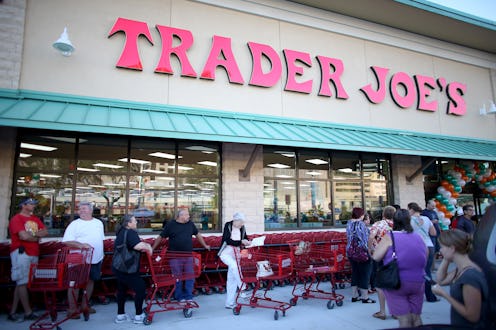Life
Trader Joe's Is Lowering The Prices On Some Of Its Most Popular Items

Ah, Trader Joe’s. The name alone is the siren call of my people. The grocery chain known for its delicious store-brand goodies and surprisingly happy employees is about to get just a little more perfect. Starting soon, Trader Joe’s produce prices will be getting cheaper. It’s like they’re reading our minds. (If they start selling free cookie butter, send help.)
As Pure Wow pointed out, the impending price drop was mentioned on a recent episode of Inside Trader Joe’s, the grocery chain’s podcast. (Yes, grocery stores have podcasts now. We have reached Peak Podcast.) On the July 22 episode, Jack Salamon, Trader Joe’s category manager for produce, noted that customers can expect to see a decrease in prices coming soon. The reason? Plastic. Or, rather, lack thereof.
“We have lots of packaging in produce,” Salamon noted, talking about how the company has been asking itself how to be more environmentally friendly in its stores. He said the company looked at what required packaging and what could be sold loose. “You’ll see it in, especially in our potato and onion section, in our apples. We have more loose apples that we did before. We have more loose potatoes and onions.”
In some instances, the excessive plastic packaging was causing Trader Joe’s unnecessary additional cost. Salamon used the example of garlic. “For years we sold them in this little pouch. And I thought, ‘Geez, why do we do that?’” he said. “Probably because that's the way we've always done it.” When they looked into it, they realized the packaging really added up. “The costs of getting those little sleeves, the costs of a little header card, the cost of putting two little cloves of garlic in those sleeves added a lot to our costs.”
“So now you can go into a Trader Joe’s and you can get a big clove of garlic for 49 cents.”
Some produce, however, still requires some sort of packaging. As Salamon said, things like loose blueberries are more difficult to sell. In those cases, Trader Joe’s is looking at how to reduce the amount of plastic in their packaging. In addition to have plastic packaging that just uses less plastic, Trader Joe’s is testing a “fiber till with plastic over wrap.” That packaging “looks like cardboard. It's biodegradable, compostable,” Salamon explained.
Earlier this year, Trader Joe’s announced they’d be reducing plastic packaging as part of a brand-wide initiative to be more sustainable. In a blog post, Trader Joe’s noted a few changes customers could expect, like “selling more loose produce items versus bunches in plastic packages” and “replacing styrofoam trays in the meat section with highly recyclable ones.”
The eco-friendly initiatives have already started to pay off. According to Tara Miller, Trader Joe's marketing director and co-host of Inside Trader Joe’s, the company’s already surpassed their yearly goal: “We are on track to eliminate 4 million pounds of plastic from our stores in 2019 and 2½ million pounds of that plastic has come directly out of the produce section.” That’s four-times higher than their initial goal of 1 million pounds of plastic reduction.
In general, Trader Joe’s tends to tout lower prices than their competitors. As Jack explains, this is in part because they’re able to buck industry standards like selling individual pieces of produce versus selling per pound. “I think a lot of customers question why the industry standard is by the pound,” Salamon said. “It’s mostly really to get them to buy more. Well, we really feel it's best to be up front with our customers and let them know what they're paying for product right off the bat.” The example he uses is with Honeycrisp apples. If you’ve ever bought a bag of Honeycrisps and were charged by the pound, you know the feeling of thinking you’re getting a good deal and then seeing the cashier ring up $15 worth of apples. Salamon notes Trader Joe’s Honeycrisp apples cost significantly less. “That’s something we're very proud of.” It’s certainly something the keeps customers coming back.